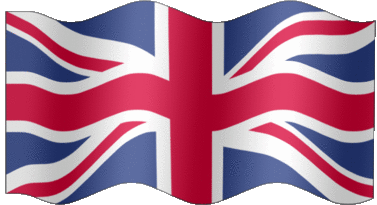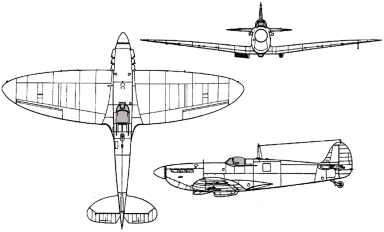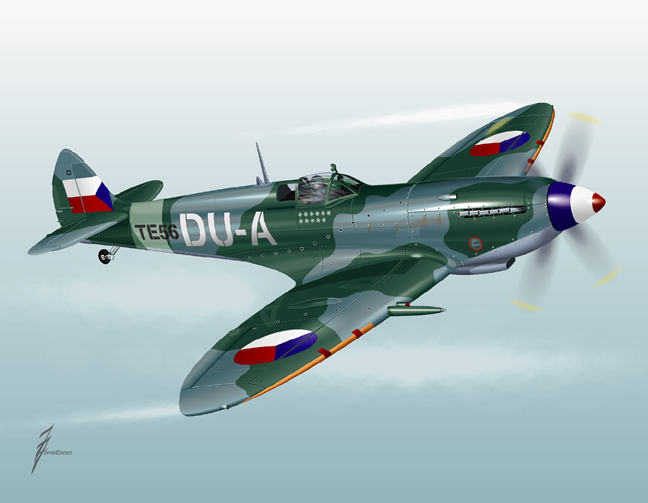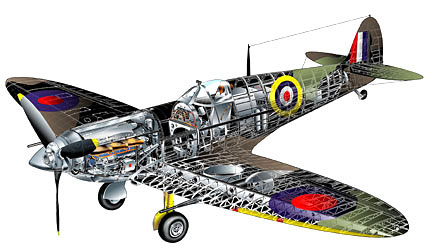 | Supermarine Spitfire. |  |
|---|
| Terran British Royal Air Force. | Terran British Royal Air Force. |
|---|
The Spitfire was re-created using lessons learned from the Hurricane series Warbirds. Though it generally outclassed the Hurricane the cost of production has been substantially higher for the Spitfire due to difficulties  | | Supermarine Spitfire Line Drawing. |
|---|
 |  | | A 22 ND Aerial Command Wing Spitfire; This is actually an EC unit. | Supermarine Spitfire Cutaway.
|
|---|
in developing the schematics; None survived the ROBOTECH WARS, so the planes had the be reconstructed from physical models- Of which no two survived the Wars intact. Some 100 partial units, many in deplorable condition, had to be manhandled into hangers for structural analysis and reconstruction.
The Spitfire is significantly faster and more agile than it's younger brother, with longer legs AND greater weapons capacity; It's also having trouble getting off the ground, literally and figuratively- It requires four TIMES the runway for normal takeoff, along with the development issues that plagued the program.
Historically the Supermarine Spitfire was bred out of British racing mono-planes of the 1920's to become a single-seat fighter intended as a short-range interceptor by Reginald Joseph MITCHELL (20 May 1895-11 June 1937), holder of Commander of the Order of the British Empire (CBE) and Fellow of the Royal Aeronautical Society. At the time he was Chief Designer at Supermarine Aviation Works, who continued to refine the design until his death from cancer in 1937; Joseph SMITH then took over as Chief Designer. The Spitfire's elliptical and thin cross-section wing had a much higher top speed than other, essential to carry out the mission of home defense; Because of this, the Spitfire was the primary RAF fighter of the Battle of Britain. Afterwards the Spitfire became the backbone of RAF Fighter Command and served in several roles, including interceptor, photo-reconnaissance, fighter-bomber, carrier-based fighter, and trainer.
The modern version has very little changes, except as needed to bring it to modern mechanical needs of UGC member-states; Specifically, the addition of grav pods, conversion to hydrocell engines, and addition of modern avionics. It's a frustrating matter to engineers on the militry project, because they can't seem to figure out what's wrong (it should need half the takeoff and practically no landing distance), and in Operator's Manuals recommend that pilots use the grav pods to "assist" takeoff (allowing VTOL).
Main User: Royal British Conglomerate (still called Great Britian)
Other Users:
European Collective
Mars Central Colony
Name: Supermarine Spitfire
Model Type: Warbird
Class: Pursuit/Fighter
Crew: One.
Passengers: None.
MDC By Location: |
Fuselage-
Engine Compartment-
Cockpit Canopy-
Wings (2)- | 175
200
90
125 | Tailerons (2) & Rudder-
Props (4)-
Landing Struts (3)-
| 100 each
75 each
10 each
|
| Speed and Statistical Data: |
Maximum Speed: 448 mph (720km/h).
Cruising Speed: 321 mph (516.5kph).
Range In The Air: 1,135 miles (1,826km).
Service Ceiling: 44,500 ft. (13,563m).
Climb Rate: 1,000 ft/min.
Takeoff Length: 200 ft unassisted.
Landing Length: 45 ft unassisted.
Height: 12 ft 8 in (3.85m).
Wingspan: 36 ft 10 in (11.23m)
Length: 32 ft 8 in (9.95m). | Weight: 8,500 lb (3,855kg).
Fuel Capacity Internal: 85 Imperial gallons.
Cargo: Pilot's supplies only.
Power System: Rolls Royce Griffon 105; Output: 31,000 hp at 2,020 KhW.
Flight Systems:
Primary: Standard Grav Pods.
Secondary: Aero-Foil Effect.
Cost and Availability: 25,000credit each; Takes about 6 months for delivery.
Black Market Cost and Availability: 5,000 to 250,000credit each; Not currently available. |
Weapons Systems:
The main M-3 Machinegun can easily enough be replaced with similar weapons (thought the M-550d requires the barrel aperture to be widened, which KDAS does not support). A common selection is the L-02a (which KDAS does support), since it supplies the plane with 2 and a half times the ammo. |
1. Five .50 Caliber M-3 Machineguns: The general purpose weapon of the Warbird series; A fully automatic, heavy machinegun has been around since the early 20ᵗʰ Century on Earth, and nearly identical ones have existed just about everywhere. In all mechanical functions, the Regult Series Battle Pods auto-cannon is so similar that some would call them identical; Only the caliber is significantly different (and thus, the engineering is SLIGHTLY different). The addition of Depleted Uranium rounds to the available inventory has added to the lethality of the .50's significantly. Also, during the War with the Regent, Plasma-662 propellant was developed; The charge was reduced to exactly emulate the effect of Cordite propellant, so it does NOT effect the damage. Purpose: Anti-Personnel/Armor Purpose: Anti-Personnel/Armor
Damage: Lead (Ball) shot: 7D6 Per round; Depleted Uranium rounds: 1D6 times 10 MD per round; Burst fire only.
Rate of Fire: Burst fire only; Fires a 10 round burst per pilots attacks per melee. .50's used on the Warbird series were specially modified at the factory to be burst fire only.
Range: 600 feet
Payload: 50,000 rounds are normally carried- That's 10,000 bursts.
Weight: 50 lbs
Cost and Availability: 5,000 credits; Occasionally available. Highly sought after, and made by a wide number of black marketeers.
Ammo Cost and Availability: Ball rounds: 800 to 1,000 credits for a box of 50; Routinely available. DU rounds: Up to 100 thousand credits for a box of 50; Rare. Highly sought after. | 2. Wing Mounted Weapons Systems: The plane can carry up to 3 pods (1 each wing and 1 undercarriage).
A) M-7 Rocket Launcher: 24 2-inch rocket tubes in 12 rows of 4 each. Each rocket tube has 4 rockets.
Purpose: Heavy Assault
M.D.: Each rocket does 2D6 M.D.
Rate of Fire: Volleys of 6 or 12 times pilots attacks per melee.
Range: 12,000'
Payload: 96 per pod. Up to 6 pods can be carried.
B) M-11 Torpedo Pod: An ASW torpedo pod. Carries the Mk-82 Airborne Torpedo essentially a modified version of the Mk-81 Submarine Launched Torpedo. The initial launch is by a nothing so complicated as releasing it from the latches that hold it to the pylon. The on board hydro-cell motor then takes over as soon as the torpedo splashes. Each pod hold 3 Mk-82's.
Purpose: Offensive/Anti-Ship
M.D.: 4D6 times 10 per torpedo
Blast Radius: 40'
Maximum Range: 80 miles
Minimum Range: 5 miles
Rate of Fire: 1 torpedo per pilots attacks per melee.
Payload: Each pod holds 3 Mk-82's.
C) M-12 Fuel Pod: Essentially a modified version of the M-11 Torpedo Pod. In this case, however, it is used as a fuel pod to double the normal range of the craft.
D) C-441 Canister Pod: Basically a hollowed out version of the M-7 pod, used to drop highly sensitive and extensive messages. A nose-mounted device using GPS or laser detection guides the pod to within 1/8th of an inch of the intended target.
|
| Features: |
- Radar: Combat grade radar. Range 100 miles, can track up to 200 individual targets. 90% reliability (no reliability against unfriendly stealthed air vehicles, 10% against unfriendly ground vehicles).
- Electronic Counter Measures (ECM): These systems disrupt enemy radar and tracking systems, making it difficult for them to lock onto the ship with weapons. The countermeasures give the Mecha a +3 to dodge, +2 to strike and +1 on initiative in combat.
- ESM: Radar Detector. Passively detects other radars being operated.
- AJP: Active Jamming Pod. Causes-25% to detection but when it is active, other vehicles/bases can detect that it is jamming, and some missiles will home in on jamming signals. Jamming also causes a-4 penalty to all radar guided weapons.
- GPS: Standard tracking device. Ties into the Blue Force Tracker.
- Full range optic sensory suite: Infrared, ultra violet, Magnification, night sight, color filters, thermal imager. Range is about 200 miles for MOST sensors.
- Motion Detector: Activates a loud wailing when an object is coming at the user fast, and a soft ringing if it's coming slowly. Activation ranges must be specified by the pilot.
- Blue Force Tracker: Identifies friend from foe. Overlays the information on both the radar and HUD, ensuring that friendly forces are not accidentally targeted.
- MRA 6 Radios: Allows real time, continuous radio link up with friendly forces in the area via satellite relay over laser radio signals, preventing jamming, and automatically encrypts/decrypts same to prevent eavesdropping.
- Type-11 wide band radios: Effective 10 mile range, auto encrypt/decrypt. Works on standard radio band wavelengths, so it can still be jammed (if the enemy knows the frequencies).
- HUD: Displays targeting, airspeed, artificial horizon, and true direction information directly in front of the pilot.
- Visor Display: Anything that can be seen on the HUD can be set in the visor, either as an overlay OR as a pop-up.
- Combat/Targeting Computer: Records all enemy and friendly activity over the course of time; Can replay that activity for the pilot, assign target designation numbers, and track likely damage based on mathematical formulas (i.e. "Right leg red" badly damaged/destroyed, "head green" not damaged, etc). Displays this information as a pop up in the HUD as requested by the pilot.
- Video Camera: 20,000 times zoom lens, records all data observed by the unit. 5,000 hours of recording available.
| - FLIR/SLIR: Forward and Side Looking Infrared. Allows pilot to get visuals on targets at night.
- Grav Clamps: Grav pods in the wheels of the landing gears allow the planes to adhere to the hulls of Warships and the exteriors of SOME buildings up to a full 90 degrees angle (nose up, down, or to the sides doesn't matter).
- Variable Tint Cockpit Canopy: Adjusts tinting to light conditions, up to an including a black dot if the sun is directly on the pilots face (only covers eyes).
- Fire Resistance: Fires external to the craft are not felt at all.
- Decoys: Specially modified Mini-Missiles used as decoys; Burning globs of magnesium/aluminum alloy to confuse both radar AND heat sensory systems, as well as creating a lot of smoke to obscure the Mecha. NOTE: Though the modified mini-missiles combine smoke flares, AMC/FDs, and LDP's, they aren't powerful enough for use with Destroids/Guardians/Etc. Reduce effects by 20% against smart missiles (add +20% to rolls for smart missiles).
Effect:
01-50: Enemy missile or missile volley detonates in chaff cloud- Missiles are all destroyed.
51-75: Enemy missile or missile volley loses track of real target and veers away in wrong direction (may lock onto another target).
76-00: No effect, missile is still on target.
Also note that the chaff cloud will also blind nearby heat sensors (and optically based sensors at night) for 1 melee. They will suffer the following penalties: Reduce melee attacks/actions, and combat bonuses by half. Also, a cloud of smoke approximately 253 feet wide and high by about 1 half-mile long.
Duration: 1D4 melee rounds.
Rate of Fire: Once per melee.
Payload: 6 chaff/flares. - Survival Pack: A pack of simpler emergency survival supplies: Pup tent, sleeping bag, black light, GPS, First aid kit (bandages, gauze, bandage tape, pads, antiseptic/analgesic), plasma torch (for small repairs and starting fires), repair kit (with MDC Repair Spray), sewing kit (a small spool of thread and 5 needles), 7 star flares (250 foot apogee), 100 feet of black or brown parachute cord (150 lbs tensile strength; This is in addition to several hundred feet from their parachute itself), 2-5 days rations, 2 gallons water, water purification kit (good for about 10 gallons), self-inflating lifevest (15# buoyancy), manual-inflation survival raft (for at-sea abandonment).
|
Combat Bonuses from Supermarine Spitfire Fighter Elite:- 3 additional attacks per melee.
- One additional Attack Per melee at levels 3, 6, 9, and 12 with any additional bonuses for the pilot.
- +5 Strike to aircraft.
- +6 Dodge.
- +3 Dodge to left/right (with propeller spin/in addition to standard dodge).
- +3 Dive Dodge (in addition to standard dodge).
- +6 Roll.
|